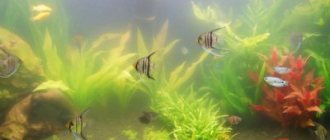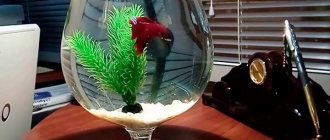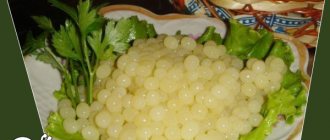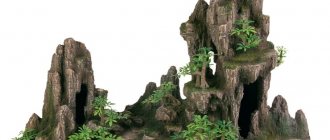Nowadays volcanic lava is used very widely in the aquarium. You can start with a simple Lava Lump for aquarium design:
This stone has many more benefits than it seems. The very first thing you may notice is the weight. An ordinary stone the size of a football will weigh about three to four kilograms. At the same time, the same Carpathian stone will weigh 10-12 kg. Next, what you can pay attention to are the interesting shapes of the lava, as well as the magnificent texture of each stone. Despite the price, lava will be cheaper than many other stones.
If we take smaller pieces of lava, we will get wonderful stones for fixing mosses, bucephalandra and other plants.
We get a beautiful and very comfortable island with moss.
Due to its porosity, mosses and other plants grow to lava much better and faster than to other stones or driftwood.
We went a little further and added lava cut into plates of small thickness 1-2cm to our assortment. If you don’t need lava hills, but just a flat, light surface, then this option will clearly interest you.
On such lava the plants will be well fixed and everything will look neat.
Also in our assortment there are as many as 3 fractions of crushed volcanic lava:
The 1st version of the 10-25mm fraction is most often used for external filters, sumps (SAMP) and even industrial filter systems. Again, porosity and lightness make this material very convenient and suitable for these tasks.
2nd fraction 3-9mm. Used as a substrate under the main primer. The small pores of the material activate biological activity and help release bioelements necessary for plants. As a result, rapid growth of plants is observed in the aquarium. Guarantees the maintenance of ideal conditions over a long period of time for the development of the plant root system and the activity of beneficial bacteria.
And the 3rd fraction is the smallest 1-3mm. Also suitable as a substrate for soil. Can be used to replace the main primer. It is a kind of analogue of the well-known neutral soil MANADO from JBL. Due to its low specific gravity, the soil ensures good water circulation, which prevents the possibility of “souring” and promotes good growth of aquarium plants.
Thus, Volcanic lava is used very widely and has many benefits. All items that are listed in the article are in our assortment in the Stones>Lava category.
Lava is a natural material with a porous structure, making it an excellent natural filter. Softens water, eliminates both visible and microscopic pollution, removes from the aquarium many harmful substances resulting from the life of fish, such as ammonium, nitrates, nitrites. Promotes the development of bacteria that destroy biological waste and reduce nitrogen concentration. Destroys various harmful microorganisms.
About the benefits of Lava for an aquarium
Nowadays volcanic lava is used very widely in the aquarium. You can start with a simple Lava Lump for aquarium design :
This stone has many more benefits than it seems. The very first thing you may notice is the weight. An ordinary stone the size of a football will weigh about three to four kilograms. At the same time, the same Carpathian stone will weigh 10-12 kg.
Next, what you can pay attention to are the interesting shapes of the lava, as well as the magnificent texture of each stone. Despite the price, lava will be cheaper than many other stones.
If we take smaller pieces of lava, we will get wonderful stones for fixing mosses , bucephalandra and other plants.
Due to its porosity, mosses and other plants grow to lava much better and faster than to other stones or driftwood.
The assortment includes lava cut into plates of small thickness 1-2 cm. If you need a flat, light surface, then this option will obviously interest you. On such lava the plants will be well fixed and everything will look neat.
Pros of use
Installing a sump in an aquarium has its own advantages:
- gives a water cycle, maintaining stable acidity, alkalinity, temperature;
- reduces the likelihood of bacteria;
- quickly and effectively clears debris;
- eliminates the possibility of overheating of the reservoir;
- makes the aquarium more visually attractive by removing equipment;
- maintains a constant water level;
- mixes water well;
- enriches water with oxygen, replacing the aerator;
- creates a stable, gentle current.
Lava in an aquarium
Lava in an aquarium is an extremely useful thing! It does not affect the basic parameters of water (pH and kH) because it is neutral.
It can be used as an element of “hardscape” or as decoration. Mainly large pieces are used, and mosses, ferns and anubias are perfectly attached to it.
Lava, 9–15 mm in size, is often used as a filler for an external filter . Thanks to its porous structure, it has a large landing area for nitrifying bacteria and perfectly retains mechanical suspension.
Lava, 7–12 mm in size, is an indispensable element of the substrate for the main soil , since it combines a drainage system and helps the soil not to sour. Also, lava accumulates silt with nutrients, which are absorbed in free form by higher plants.
Among other things, the lava contains almost the entire range of mineral compounds necessary for the growth and development of our green pets, including potassium (K), magnesium (Mg), zinc (Zn) and most importantly - iron (Fe), or rather its divalent compound (FeOH2), which solves the problem of plant chlorosis.
Red lava is especially rich in iron oxide. First of all, we note that iron is a polyvalent element and under normal conditions can exist in two forms: divalent (reduced) and trivalent (oxidized). Plants for the most part need divalent.
Why do you need a samp
It is recommended for all owners of large tanks of 300 liters or more to install the equipment, since it will not be possible to achieve a perfect water cycle on their own.
In a large tank, the sump performs a number of important functions:
- stirs the water;
- creates a constant, gentle current;
- prevents the formation of films on the water surface.
Many aquarists buy a sump so as not to clutter up a pond with fish with unnecessary equipment. The equipment inside the aquarium spoils the design and interferes with some inhabitants.
The sump must be placed in a sea body of water. This will make it easier to care for seawater and its inhabitants.
Summary
Lava can be used as soil, a nutrient substrate for soil, and a biofiller. Natural lava from the Russian deposit is in no way inferior to foreign analogues (jbl proscape, ada biorio, etc.).
Volcanic gravel with a very porous surface is ideal for colonies of nitrifying bacteria; the porous surface allows good water circulation, preventing siltation.
The fine fraction can be used as soil in small aquariums, the medium fraction as a nutrient substrate in aquariums with live plants, and the large fraction as material for biofiltration in a sump or external filter.
Which stones are preferable?
While it may seem like there are a lot of restrictions when choosing rocks for your home aquarium, there are still a huge number of rocks that are safe for your aquarium. These stones can be easily found in most areas and are easy to identify.
Here are some rocks that are completely safe to place in your aquarium:
Be sure to only use stones that belong to the ones listed above. Although some of the rocks on the list tend to increase acidity (pH) and hardness (dH), this is actually negligible and can be neglected.
Rocks to avoid are carbonate rocks. They can increase the acidity and hardness of water and significantly affect the well-being of aquarium inhabitants. Be sure to regularly check your water chemistry if you want to ensure optimal pH and dH.
Because carbonate rocks can be mistaken for other rocks, you should know how to test for them. The easiest way is to apply a few drops of vinegar to the surface of the stone. If gas begins to form on the droplets, then most likely the stone contains carbonates. Using this type of rock in an aquarium can make the pH and dH unpredictable.
The most common carbonate rocks are:
Preparing rocks before placing them in the aquarium
Once you have chosen the stones, the next step is to prepare them for placement, namely cleaning them from various contaminants. Stones should be cleaned with a hard brush in running water. When cleaning stones, use only a brush and water. After the mechanical cleaning of the stones has been completed, it is necessary to boil them in order to finally get rid of chemical impurities and bacteria. Boiling will kill any bacteria that may still be inside the rock crevices.
Boiling stones
Take a large saucepan in which you place the stones and fill them with water. The stones must be completely under water. Do not add any additives to the water. Bring the water to a boil and then boil the stones for 20-30 minutes. After boiling, place the stones on a paper towel to dry. Usually one hour is enough for this. Once the stones are dry, they can be placed in the aquarium.
What is samp
An aquarium sump is a separate tank that is placed under a home pond. It is connected to the reservoir with hoses for supplying and draining liquid. It turns out to be a natural biological filter. The water is not purified in the fish pond itself, but in a separate tank. A favorable environment is created for all aquatic inhabitants.
The aquarium sump is made of glass and is divided into several compartments:
- in the first compartment there is a filter made of padding polyester or sponge;
- in the second compartment there is a filter with expanded clay;
- in the third compartment there is a water heater.
The liquid enters the device and goes through all stages of cleaning. At the final stage, it is heated to the desired temperature and returned to the tank.
There are many types of sumps, which are selected according to needs, type of reservoir inhabitants, and purposes.
Advantages and disadvantages
A sump for an aquarium is an installation that brings with it many positive aspects:
- prevents the appearance of film on the surface of the water and the accumulation of debris;
- maintains the same water level;
- creates an additional current;
- saturates with oxygen.
The disadvantages of samp are as follows:
- noisy work;
- equipment requires additional space.
There is another drawback - the need to make holes at the bottom of the aquarium. Owners of a homemade sump get around this problem by installing a pump. True, the operation of such a device will completely depend on an uninterrupted supply of electricity.
How to make a sump for an aquarium with your own hands
You can buy ready-made samp in the store or make it to order. The device is quite expensive, so some aquarists make a technical tank with their own hands. When making a sump with your own hands, you decide how many and what compartments will be in the system. You can experiment with cleaning methods, change compartments, add or remove filters. To make your own sump, you will need a glass tank, separate aquarium equipment and a lot of patience.
Creating a samp begins with drawing the project. When creating a project, you need to pay attention to the dimensions of the technical aquarium. The size of the sump should correspond to the main aquarium. The technical tank must have access to all compartments. When there is a power outage, the sump must contain all the water from the aquarium. Ready-made projects with detailed descriptions can be found on the Internet.
When making a structure, it is necessary to take into account important details:
- Only special silicone glue is used to glue the glass tank;
- the thickness of the glass walls must be at least 5 mm;
- the width of each compartment should not be less than 10 cm;
- when installing partitions, you need to check the tank for leaks;
- in order for water to pass through the partitions, the lower distance should be 2 cm above the bottom of the tank;
- each partition is installed after gluing and drying the previous one;
- the drain can be located at the bottom or in the side;
- The drain is separated from the rest of the tank with a comb or brush.
Drilling glass must be done with extreme caution. Any wrong or sudden movement will cause it to burst. Experts recommend using a diamond-cut drill. Drilling should be done at low speeds; do not push or press on the tool. The drill is held strictly in a vertical position. To avoid damaging the glass, it is recommended to pour a little water into the drilling area.
Electrical equipment used in a technical aquarium must be packaged in waterproof casings. It is recommended to purchase special equipment for aquariums. All wires are hidden in sealed false panels.
After installing and connecting the sump, at least a month must pass before the water begins to be effectively purified. Sump is the most effective way to purify aquarium water in large tanks. It regulates water parameters itself, heats the liquid to the desired temperature, and completely removes all impurities, including nanoparticles and organics. Samp returns the reservoir to a favorable biological environment and creates ideal conditions for fish to live. It is impossible to imagine a marine aquarium without a sump, because it creates all the conditions for maintaining a salty environment.
How does samp work?
Water is cleaned through the sump in stages. First, the liquid enters the first half, where large particles and suspensions are removed. Then the liquid is sent to the second compartment, where it is cleaned of organics and biological substances. In the third compartment, the water is heated and sent back to the tank with the fish. Some sumps additionally contain a nitrate neutralizer, mineralizer or aerator. SAMP is also known as “technical aquarium”.
Sea samp
Sumps are most often placed in marine aquariums, because the equipment makes it possible to maintain optimal marine biosrera. The marine itself consists of:
- kalkwasser;
- skimmer;
- carbon filter;
- scrubber;
- refugium.
Kalkwasser
Kalkwasser is a compartment of the sump in which the water is enriched with calcium. Such equipment is installed in aquariums in which corals are grown.
Skimmer
This is an additional compartment of the sump in which the water is purified from organic matter. When water enters the skimmer, it foams under the action of a compressor that pumps in oxygen. The foam rises and falls into a small reservoir, where a dark liquid of organic matter is formed. The contaminants remain in the filter, and the purified water goes further through the sump.
Carbon filter
The carbon filter collects small suspended particles that are invisible to the naked eye. The porous structure of the filter traps even nanoparticles. The filter is placed immediately after the skimmer.
Scruber
A system that removes phosphates and ammonia from water. The installation occupies an additional compartment of a technical aquarium. Externally, the scrubber looks like a small mesh through which water flows. This mesh is illuminated by a lamp, so it is completely covered with algae. Algae collect all chemical elements.
Refugium
System for enriching water with oxygen. In this compartment, the water is saturated with oxygen, and the level of acidity and alkalinity is checked. A sump for a marine aquarium is much more complex in design than a freshwater one, since many factors must be observed to maintain the marine biological environment.











